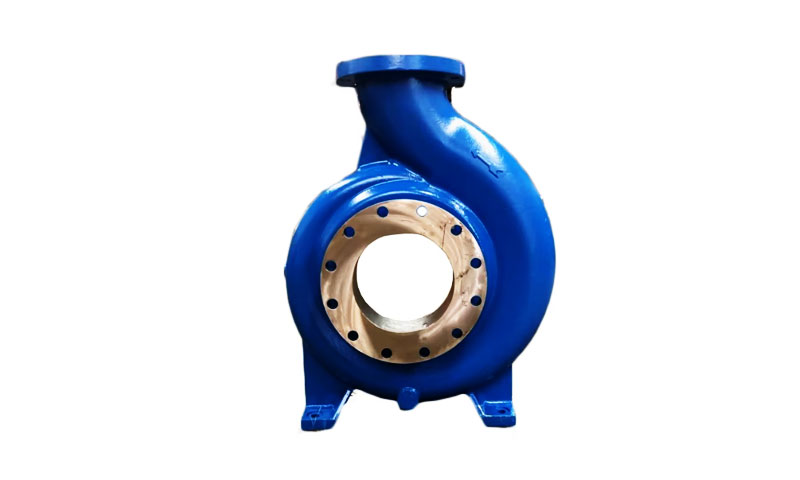1. Giới thiệu
Pump bodies are structural and hydraulic housings that convert driver energy into fluid motion. They commonly contain volutes, impeller seats, bearing bosses, flanges and internal passages.
The manufacturing route chosen for a pump body sets achievable geometry, luyện kim, cost and lead time.
Investment casting stands out where geometry is complex (internal guide vanes, thin webs, integrated bosses), tolerances are tight, and high-integrity alloys (Thép không gỉ, Hợp kim niken, Đồng) được yêu cầu.
2. What Is an Investment Casting Pump Body?
Definition and core functionality
MỘT Đúc đầu tư pump body is a pump housing produced by the lost-wax (sự đầu tư) Phương pháp đúc.
A wax (hoặc polymer) pattern of the pump body is created, coated in refractory ceramic to build a shell, the wax removed by heating, and molten metal poured into the ceramic mold.
The fired shell is broken away after solidification to reveal a near-net cast pump body that is subsequently finished and inspected.
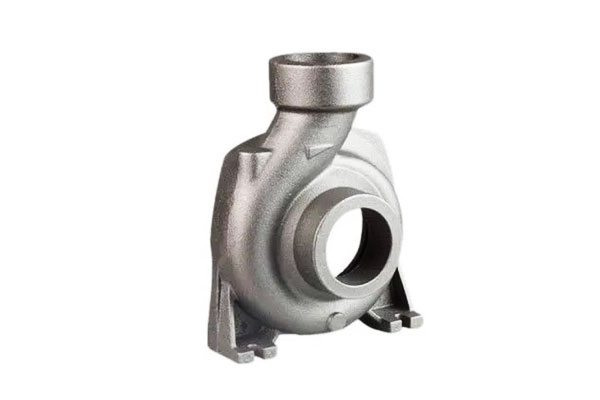
Typical specifications and dimensions
- Part mass: investment cast pump bodies usually range from a few hundred grams to tens of kilograms per piece; many foundries routinely cast pump bodies from ~0.5 kg up to ~50–100 kg depending on plant capability.
- Độ dày tường: typical nominal walls for stainless or nickel alloys: 3Mạnh12 mm; minimum thin sections down to 1Mạnh2 mm are achievable in selected alloys and process control.
- Dung sai kích thước (như đúc): general investment cast tolerances commonly fall in ± 0,1 Ném0,5 mm for small features; percent-based tolerance of ±0.25–0.5% linear is a practical rule of thumb.
Critical machined features are usually left with machining allowance (0.2–2.0 mm depending on casting accuracy). - Bề mặt hoàn thiện (như đúc): typical Ra 1.6Cấm3.2 μm (50Mạnh125 phút) for standard ceramic shells; fine shells and careful pouring can produce Ra ≈ 0.8–1.6 μm.
Sealing faces or bearing journals are machined/lapped to much finer Ra (≤ 0.2 μm) as required.
3. Cân nhắc thiết kế
Investment casting enables complex geometry, but good design practice maximizes quality and minimizes cost.
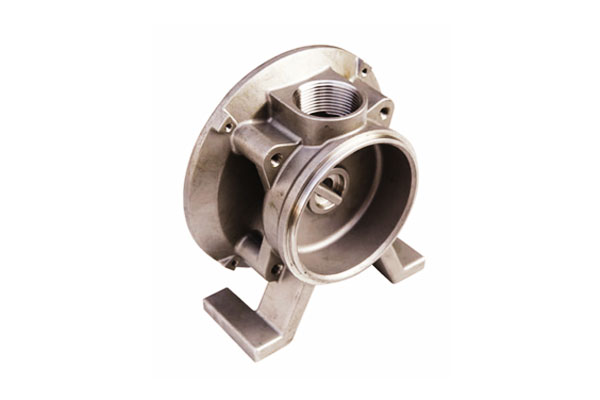
Hydraulic performance requirements
- Flow passages & volutes: smooth fillets and controlled convergence avoid separation and cavitation.
Internal fillet radii should be generous (≥ 1–2× wall thickness) to reduce turbulence. - Impeller seat alignment: concentricity and perpendicularity are critical — plan for machined bores and datum features.
- Clearances: pump clearances at impeller overhangs and seal faces must be maintainable by post-cast machining.
Structural requirements
- Stress & Mệt mỏi: consider cyclical loads; use finite-element analysis to identify local stress risers.
Cast metallurgy (Kích thước hạt, sự tách biệt) affects fatigue life—design to avoid thin, highly stressed bosses without proper filleting. - Vibration: stiff webs and ribs help raise natural frequencies; investment casting allows ribs to be integrated into the body.
Ăn mòn & mặc
- Lựa chọn vật chất: choose alloy based on fluid chemistry (PH, clorua, Các hạt xói mòn, nhiệt độ).
For seawater, duplex or cupronickel may be required; for acids, Hastelloy or appropriate nickel alloys. - Erosion resistance: smooth internal surfaces and sacrificial coatings (khó tính, Xịt nhiệt) are options where particulate slurry is present.
Dung sai kích thước & bề mặt hoàn thiện
- Các tính năng quan trọng: designate which faces/bores are finish-machined and specify machining allowances (VÍ DỤ., 0.5–1.5 mm for sandier shells, 0.2–0.6 mm for precision shells).
- Sealing surfaces: specify Ra and flatness; often lapped/polished to Ra ≤ 0.2 μm and flatness within 0.01Hàng0,05 mm depending on pressure class.
4. Materials for Investment Casting Pump Bodies
Material selection is a critical factor in designing and producing investment-cast pump bodies, as it directly affects mechanical performance, kháng ăn mòn, sản xuất, và cuộc sống phục vụ.
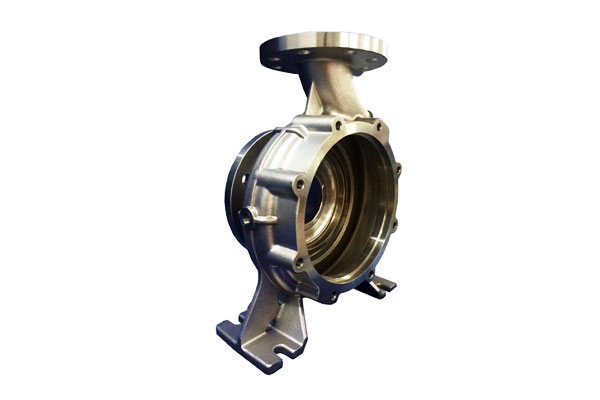
| Thể loại vật chất | Ví dụ Hợp kim | Thuộc tính chính | Các ứng dụng điển hình | Cân nhắc đúc |
| Austenitic thép không gỉ | 304, 316L | Kháng ăn mòn tuyệt vời, sức mạnh vừa phải, Khả năng hàn tốt; Kéo dài: 480MP620 MPa, Năng suất: 170Mạnh300 MPa, Kéo dài: 40–60% | General chemical pumps, xử lý nước, đồ ăn & đồ uống | Good molten fluidity, low hot-cracking risk, easy post-machining |
| Thép không gỉ song công | 2205, 2507 | Sức mạnh cao (Yield 450–550 MPa), superior chloride stress corrosion resistance | Marine and offshore pumps, aggressive chemical environments | Requires controlled temperature; post-casting heat treatment to prevent sigma phase |
Hợp kim niken |
Bất tiện 625, 718; Hastelloy | Kháng ăn mòn đặc biệt, cường độ nhiệt độ cao, kháng oxy hóa | Xử lý hóa học, sản xuất điện, dầu & khí | High melting points (≈1450–1600 °C); careful mold preheating and controlled pouring needed; difficult machining |
| Đồng and Copper Alloys | C93200, C95400 | Khả năng chống ăn mòn nước biển tuyệt vời, Kháng mặc tốt, antifouling; lower mechanical strength | Máy bơm biển, Làm mát nước biển, Thành phần thủy lực | Lower melting points (≈1050–1150 °C) simplify casting; low thermal cracking risk; mechanical strength lower than stainless/nickel |
5. Investment Casting Process for Pump Bodies
Đúc đầu tư, còn được gọi là đúc wax, enables the production of pump bodies with complex geometries, tường mỏng, và độ chính xác chiều cao.
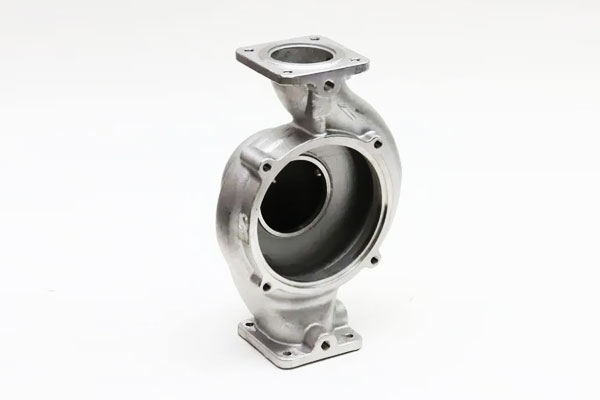
The process consists of several critical steps:
| Bước chân | Sự miêu tả | Cân nhắc chính |
| 1. Tạo mẫu sáp | Molten wax is injected into precision molds to form replicas of the pump body. | Ensure uniform wall thickness; maintain dimensional accuracy ±0.1 mm; use high-quality wax to prevent distortion. |
| 2. Assembly of Wax Tree | Individual wax patterns are attached to a central wax sprue to form a tree for batch casting. | Sprue design affects metal flow; minimize turbulence during pouring. |
| 3. Tòa nhà vỏ gốm | Repeated dipping in ceramic slurry and stuccoing with fine refractory sand creates a strong, vỏ chịu nhiệt. | Target shell thickness (51010 mm) depends on pump body size; avoid cracks and porosity in the shell. |
| 4. Dewaxing and Mold Firing | Wax is melted out (autoclave or kiln), để lại một khoang; the ceramic shell is then fired to remove residues and strengthen the mold. | Temperature ramping must be controlled to prevent shell cracking; residual wax must be fully removed. |
5. Đổ kim loại |
Kim loại nóng chảy (thép không gỉ, nickel alloy, hoặc đồng) is poured into the preheated ceramic mold under gravity or vacuum-assisted conditions. | Pouring temperature and rate must ensure complete filling; control turbulence and prevent oxide formation. |
| 6. Hóa rắn và làm mát | Metal solidifies inside the mold; cooling rates affect microstructure, tính chất cơ học, và căng thẳng dư. | Thick sections may require controlled cooling to prevent porosity; thin walls must avoid hot tearing. |
| 7. Loại bỏ vỏ | Ceramic shell is broken away mechanically, often using vibration, sand blasting, or chemical dissolution. | Avoid damaging intricate pump channels or flanges. |
| 8. Finishing and Cleaning | Residual ceramic, gating system, and surface imperfections are removed via grinding, bắn nổ, or chemical cleaning. | Maintain dimensional tolerances; prepare surfaces for subsequent machining or coating. |
6. Hoạt động sau đúc
After the pump body is removed from the ceramic shell, several post-casting operations are performed to ensure the component meets functional, chiều, và yêu cầu chất lượng bề mặt.
These operations are critical for high-performance applications in chemical, hàng hải, và các lĩnh vực công nghiệp.
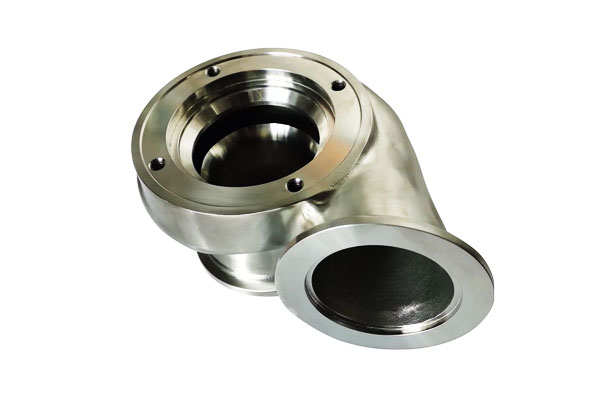
Điều trị nhiệt
Điều trị nhiệt is applied to relieve residual stresses, cải thiện độ dẻo, and optimize mechanical properties:
- Cứu trợ căng thẳng: Heating to 550–650 °C for stainless steels reduces residual stress from casting and prevents distortion during machining.
- Giải pháp ủ: Applied for stainless steels and nickel alloys to homogenize microstructure and dissolve unwanted precipitates, ensuring corrosion resistance and consistent hardness.
- Aging or Precipitation Hardening (for certain alloys): Enhances strength and wear resistance in high-performance materials.
Gia công
Critical dimensions such as flanges, Bores, mating surfaces, and threaded ports are machined to meet tight tolerances.
Typical machining operations include turning, xay xát, khoan, and boring. Machining ensures:
- Dimensional tolerances of ±0.05–0.1 mm for precise assembly.
- Smooth sealing surfaces to prevent leaks in high-pressure applications.
Hoàn thiện bề mặt
Bề mặt hoàn thiện Tăng cường khả năng chống ăn mòn, Đang đeo điện trở, và thẩm mỹ:
- đánh bóng: Improves smoothness for sealing faces and internal channels.
- Bắn nổ: Removes residual ceramic particles and creates a uniform surface for coating or painting.
- Lớp phủ: Optional chemical or electroplated coatings (VÍ DỤ., Niken, PTFE) enhance corrosion resistance and reduce friction.
Thử nghiệm không phá hủy (Ndt)
To detect defects such as porosity, vết nứt, hoặc vùi, NDT is performed:
- X quang (tia X): Identifies internal voids and inclusions.
- Kiểm tra siêu âm (UT): Detects subsurface flaws in thick sections.
- Thử nghiệm thâm nhập thuốc nhuộm (Pt): Reveals surface cracks and porosity.
Cleaning and Inspection
Cuối cùng, pump bodies are cleaned to remove residual machining oils, Mảnh vụn, or salts. Dimensional and visual inspections verify compliance with specifications before assembly or shipment.
7. Quality Assurance and Testing
Đảm bảo chất lượng (QA) is critical in ensuring that investment casting pump bodies meet design specifications, performance standards, và yêu cầu ngành công nghiệp.
A systematic QA approach combines dimensional checks, Thử nghiệm cơ học, and non-destructive evaluation to detect defects and confirm functional integrity.
Kiểm tra kích thước
Dimensional verification ensures that the pump body conforms to design drawings and tolerances:
- Phối hợp máy đo (Cmm): Measure complex geometries, Bores, mặt bích, and mounting surfaces with accuracy of ±0.01–0.05 mm.
- Gauge Tools: Thread gauges, plug gauges, and height gauges verify critical features quickly in production.
- Đo độ nhám bề mặt: Confirms finishing requirements for sealing faces and internal channels (VÍ DỤ., Ra ≤0.8 μm for hydraulic components).
Mechanical Property Verification
Mechanical testing validates that the material meets required strength, độ dẻo, và độ cứng:
- Kiểm tra độ bền kéo: Measures yield strength, Độ bền kéo cuối cùng, và kéo dài, ensuring the material can withstand operational loads.
- Kiểm tra độ cứng: Rockwell or Vickers testing confirms that heat treatment and material processing achieved the desired hardness.
- Kiểm tra tác động (Nếu được yêu cầu): Evaluates toughness for applications exposed to fluctuating loads or shock.
Thử nghiệm không phá hủy (Ndt)
NDT techniques detect hidden defects without damaging the part:
- X quang (X-ray/CT Scanning): Identifies internal porosity, Bao gồm, and voids, particularly in thick sections.
- Kiểm tra siêu âm (UT): Detects internal cracks, khoảng trống, or delaminations in dense materials like stainless steel and nickel alloys.
- Thử nghiệm thâm nhập thuốc nhuộm (Pt): Reveals surface cracks, PINSHOLES, or fine porosity not visible to the naked eye.
- Kiểm tra hạt từ tính (MT): Applied for ferromagnetic alloys to detect surface and near-surface discontinuities.
Common Casting Defects and Mitigation Strategies
- Độ xốp: Minimized through proper gating, trút giận, and controlled solidification rates.
- SHROWAGE CAUNIDE: Addressed via riser design and thermal management.
- Cảm lạnh và sai lầm: Avoided by maintaining optimal pouring temperatures and smooth flow in complex geometries.
- Surface Inclusions: Controlled by using high-purity alloys and proper degassing techniques.
8. Advantages of Investment Casting for Pump Bodies
- Hình học phức tạp: đoạn văn nội bộ, thin walls and integrated bosses with minimal secondary assembly.
- Hình dạng gần net: reduces material removal vs. rough machining from bar or billet — often 30–70% less machining cho các phần phức tạp.
- Độ chính xác chiều cao & bề mặt hoàn thiện: less secondary finishing for many features compared with sand casting.
- Alloy flexibility: cast many stainless and nickel alloys with good metallurgical integrity.
- Small to medium production flexibility: tooling for wax patterns is relatively inexpensive vs. large die tooling, enabling economic runs from prototypes to thousands of parts.
9. Hạn chế và thách thức
- Cost for very large parts: above certain sizes (thường >100 kg) investment casting becomes uneconomical compared with sand casting or fabricating/ welding.
- Thời gian dẫn đầu: pattern tooling, shell building and firing add lead time—prototype timelines usually measured in weeks.
- Porosity risk in thick sections: thick bosses or large cross-sections require careful gating, chills or segmenting to avoid shrinkage.
- Surface finish and tolerances depend on shell system: achieving ultra-fine finishes or extremely tight as-cast tolerances requires premium ceramic systems and process control.
10. Ứng dụng công nghiệp
Investment casting pump bodies are used across a broad spectrum of industries due to their complex geometry capabilities, tính linh hoạt vật chất, và độ chính xác chiều cao.
The process allows engineers to design optimized hydraulic passages, tường mỏng, and integrated mounting features that improve pump efficiency and longevity.
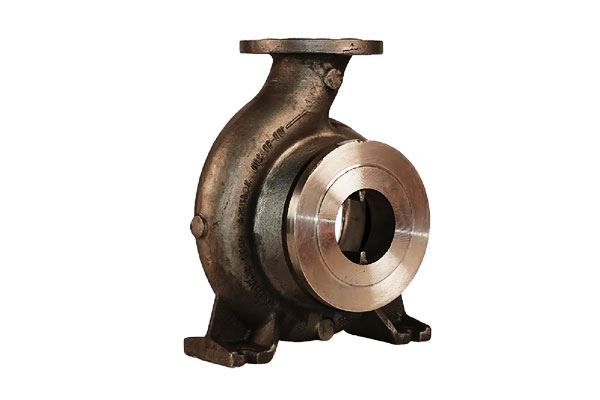
Chemical Processing Pumps
- Môi trường: Corrosive fluids such as acids, caustics, và dung môi.
- Materials Used: Thép không gỉ (316L, song công) and nickel alloys (Hastelloy, Bất tiện).
- Cơ sở lý luận: Investment casting enables intricate internal channels, minimizing turbulence and ensuring uniform flow, critical for chemical process reliability.
Water and Wastewater Pumps
- Môi trường: High-volume pumping, abrasive suspended solids, and variable pH levels.
- Materials Used: Đồng, Thép không gỉ song công, and corrosion-resistant cast irons.
- Cơ sở lý luận: Thin-wall, smooth internal passages reduce clogging and energy losses, improving efficiency in municipal and industrial water systems.
Marine and Offshore Pumps
- Môi trường: Saltwater exposure, high-pressure operation, and cyclical mechanical stress.
- Materials Used: Hợp kim đồng (Đồng thau hải quân, đồng), Thép không gỉ song công.
- Cơ sở lý luận: Resistance to corrosion and biofouling is critical; investment casting allows seamless, complex geometries to reduce maintenance and improve service life.
Dầu & Gas and Power Generation Pumps
- Môi trường: Nhiệt độ cao, high-pressure fluids, and hydrocarbon-based media.
- Materials Used: High-nickel alloys (Bất tiện, Hastelloy), thép không gỉ, and cobalt-based alloys.
- Cơ sở lý luận: Investment casting supports high-strength materials and precise tolerances necessary for critical applications such as turbine lubrication, chemical injection, and offshore drilling.
Specialty and Custom Pumps
- Môi trường: Laboratory, Dược phẩm, or food processing applications requiring hygienic and precision performance.
- Materials Used: Thép không gỉ (304, 316L), titan, hoặc hợp kim niken.
- Cơ sở lý luận: Bề mặt mịn, dung sai chặt chẽ, and complex geometries achieved by investment casting ensure minimal contamination risk and compliance with regulatory standards.
11. Phân tích so sánh
| Tính năng / Tiêu chuẩn | Đúc đầu tư | Đúc cát | Machining from Solid |
| Độ phức tạp hình học | Excellent – thin walls, kênh nội bộ, intricate features achievable | Moderate – limited by core placement and mold stability | Limited – complex internal geometries often impossible without assembly |
| Độ chính xác kích thước | High – ±0.1–0.25 mm typical | Moderate – ±0.5–1.0 mm | Very High – ±0.05 mm achievable |
| Hoàn thiện bề mặt (Ra) | Fine – 1.6–3.2 μm typical; can be polished | Rough – 6–12 μm; requires machining for precision | Excellent – 0.8–1.6 μm achievable with finishing |
| Tùy chọn vật chất | Wide – stainless steels, Hợp kim niken, đồng, Hợp kim đồng | Wide – iron, Thép, đồng, nhôm | Wide – depends on machinable stock availability |
| Kích thước lô | Low-to-medium – 1–1000+ parts | Medium-to-high – economical for large, các bộ phận đơn giản | Low – material waste increases cost for large parts |
| Thời gian dẫn đầu | Moderate – wax pattern & shell building required | Short-to-moderate – mold preparation relatively quick | Variable – depends on machining complexity |
Chất thải vật chất |
Low – near-net shape reduces scrap | Moderate – gating and risers generate some waste | High – subtractive process creates chips and offcuts |
| Chi phí cho mỗi phần | Moderate-to-high – tooling and process steps increase cost, economical for complex parts | Low-to-moderate – simpler molds, larger parts cheaper | High – extensive machining on large, complex parts is expensive |
| Sức mạnh & Chính trực | Excellent – dense microstructure, minimal porosity if controlled | Moderate – risk of sand-related inclusions and porosity | Excellent – homogeneous, Không có khuyết điểm đúc |
| Post-Processing Required | Often minimal – some machining, Hoàn thiện | Usually significant – machining and finishing required | Minimal – final finishing for tight tolerances only |
| Các ứng dụng điển hình | Pump bodies with thin walls, complex hydraulic channels, kháng ăn mòn | Lớn, simple pump housings or structural components | Custom or prototype pump bodies requiring extreme precision |
12. Phần kết luận
Investment casting pump body combines design freedom with metallurgical integrity, making them an excellent choice for many fluid-handling applications—especially where complex internal geometry, exotic alloys or tight tolerances are required.
Success depends on early design for casting, informed material selection, careful process control (rót, shelling, Điều trị nhiệt), and robust QA/NDT programs.
For critical pump systems—marine, chemical or power generation—investment casting can deliver reliable, economical components when specified and executed correctly.
Câu hỏi thường gặp
What maximum size of pump body can be investment cast?
Typical shop practice ranges up to ~50–100 kg per part, but the practical maximum depends on foundry capability and economics.
Very large pump bodies are more often produced by sand casting or fabricating/welding.
How much machining allowance should I design into an investment casting?
Cho phép 0.2Cấm2,0 mm depending on the criticality and shell precision. Specify tighter allowances only where the foundry guarantees precision shells.
Which material is best for seawater pump bodies?
Duplex stainless steels and selected copper-nickel alloys are common choices due to superior chloride pitting resistance and biofouling performance; final selection depends on temperature, velocity and erosion conditions.
What is the typical turnaround time for an investment-cast pump body?
Small production runs typically take 4Tuần8 tuần from pattern approval to finished parts; single prototypes can be faster with 3D-printed patterns but still require shell firing and melt schedules.
How do I specify acceptance criteria for porosity?
Use industry NDT standards (X quang, CT, UT) and define acceptance levels in percent porosity by volume or via reference images.
Critical pressure-retaining pump bodies often require porosity <0.5% by volume and radiographic acceptance per customer standard.
